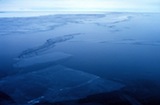séminaire – jeudi 25 octobre 2018
 Paléoenvironnements et foraminifères antartiques
Paléoenvironnements et foraminifères antartiques
Wojciech Majewski (Institute of Paleobiology, Polish Academy of Sciences, Warszawa)
jeudi 25 octobre 2018, à 13 heures, amphithéâtre Guyton de Morveau
Foraminifera from sub-ice-shelf and near grounding zone paleo-settings of the Ross Sea, Antarctica Paleoenvironmental reconstructions of Ross Sea environments based on foraminifera are hindered by the dearth of actualistic data, especially from below the Ross Ice Shelf. To fill this gap, well-resolved deglaciation records from the Ross Sea were used to understand the ecological affinities of different foraminiferal assemblages. During the present-like open-water conditions, benthic foraminiferal assemblages, strongly dominated by agglutinated species, were present. However, in older sediments, different assemblages of calcareous foraminifera were identified. By Antarctic margin standards, these calcareous assemblages could be periodically trully abundant, supplying enough in situ biogenic carbonate for radiocarbon dating. Along with assemblages dominated by benthic calcareous species that are well known from many Antarctic settings, two important assemblages were dominated by a heretofore undescribed pustulose/spinose morphotypes of Globocassidulina biora and Trifarina earlandi. Based on correlations to deglacial records, these two assemblages inhabited near the grounding line or in environments with water current activity and represented rare examples of calcareous benthic foraminiferal ecotypes that were well adapted to extreme Antarctic environments. They are most likely ecotypes within broadly distributed Antarctic species, which stays in line with their complex genetic population structures.
- extrait:
- lien_externe:
- kc_data:
- a:8:{i:0;s:0:"";s:4:"mode";s:0:"";s:3:"css";s:0:"";s:9:"max_width";s:0:"";s:7:"classes";s:0:"";s:9:"thumbnail";s:0:"";s:9:"collapsed";s:0:"";s:9:"optimized";s:0:"";}
- kc_raw_content:
 Paléoenvironnements et foraminifères antartiques
Paléoenvironnements et foraminifères antartiquesWojciech Majewski (Institute of Paleobiology, Polish Academy of Sciences, Warszawa)
jeudi 25 octobre 2018, à 13 heures, amphithéâtre Guyton de Morveau
Foraminifera from sub-ice-shelf and near grounding zone paleo-settings of the Ross Sea, Antarctica Paleoenvironmental reconstructions of Ross Sea environments based on foraminifera are hindered by the dearth of actualistic data, especially from below the Ross Ice Shelf. To fill this gap, well-resolved deglaciation records from the Ross Sea were used to understand the ecological affinities of different foraminiferal assemblages. During the present-like open-water conditions, benthic foraminiferal assemblages, strongly dominated by agglutinated species, were present. However, in older sediments, different assemblages of calcareous foraminifera were identified. By Antarctic margin standards, these calcareous assemblages could be periodically trully abundant, supplying enough in situ biogenic carbonate for radiocarbon dating. Along with assemblages dominated by benthic calcareous species that are well known from many Antarctic settings, two important assemblages were dominated by a heretofore undescribed pustulose/spinose morphotypes of Globocassidulina biora and Trifarina earlandi. Based on correlations to deglacial records, these two assemblages inhabited near the grounding line or in environments with water current activity and represented rare examples of calcareous benthic foraminiferal ecotypes that were well adapted to extreme Antarctic environments. They are most likely ecotypes within broadly distributed Antarctic species, which stays in line with their complex genetic population structures.
- titre:
- Paléoenvironnements et foraminifères antartiques
- intervenant:
- Wojciech Majewski
- date:
- jeudi 25 octobre 2018
